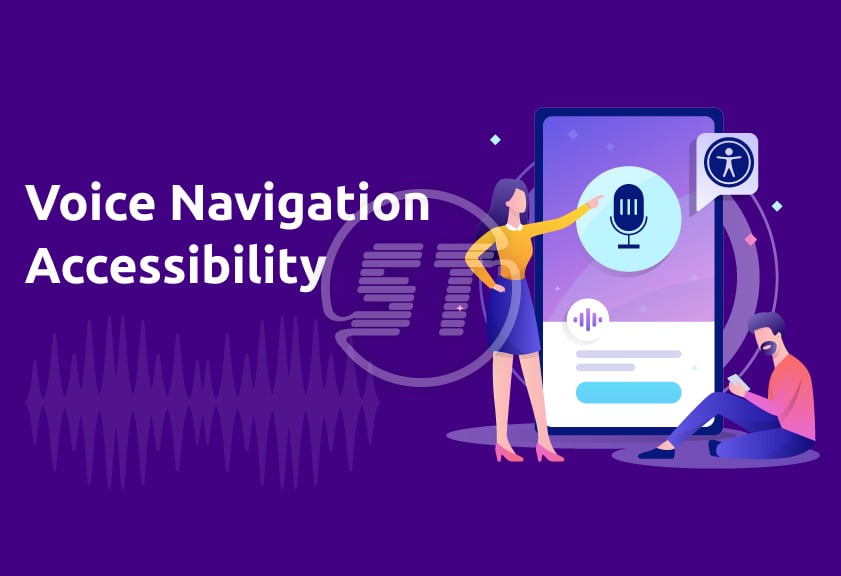Today websites are central to how people interact with the world because they serve as gateways to information, services, and communication. However, not everyone experiences the web in the same way. For individuals with disabilities, traditional navigation methods can pose significant challenges.
Voice navigation technology offers a transformative solution, enhancing user experience and accessibility across websites. Thus, crafting immersive voice UI (user interface) designs is significant to cater to the growing demand for voice interaction.
This article will shed light on voice navigation, which is a crucial facet of digital accessibility.
Impact of voice navigation on digital experiences!
Inclusivity and accessibility
Voice navigation makes websites more accessible to people with various disabilities. Screen readers help, but they often require extensive keyboard use and can be cumbersome. Voice navigation allows users to speak commands and hear responses, making interaction smoother and more intuitive. Similarly, individuals with motor impairments, who might struggle with mouse and keyboard inputs, can benefit greatly from voice-activated controls.
Enhanced user experience
Voice navigation can significantly improve the overall user experience for everyone. It allows for hands-free operation, particularly useful when users cannot use their hands, such as while cooking, driving, or multitasking. The ability to perform tasks using simple voice commands can make browsing more efficient and enjoyable.
Increased efficiency and speed
Voice commands can expedite the navigation process. Instead of clicking through multiple menus and links, users can directly command the website to take them where they want to go. For example, saying “Search for nearest restaurants” or “Open my profile settings” can be much faster than manually navigating through pages. This streamlined interaction can save time and reduce frustration, creating a more satisfying user experience.
Improved accessibility compliance
In many countries, there are legal requirements for websites to be accessible to people with disabilities. Implementing voice navigation can help websites comply with these regulations, such as the Americans with Disabilities Act in the United States. By adopting voice navigation, websites not only meet legal standards but also demonstrate a commitment to inclusivity and accessibility.
Broader user base
Enhancing accessibility through voice navigation can attract a wider audience. Older adults (not internet-savvy ones) can benefit from the simplicity of voice commands. Additionally, other non-tech savvy individuals can also reduce their struggle to navigate difficult interfaces by using simple and intuitive voice navigation options.
Personalization and interactivity
Voice navigation can be integrated with personalized features, making the user experience more engaging. For example, websites can recognize individual users’ voices and offer personalized content and suggestions based on their preferences and past interactions. This level of customization can lead to a more interactive and satisfying user experience, fostering a deeper connection between users and the website.
Futureproofing
As voice assistants like Siri, Alexa, and Google Assistant become increasingly prevalent, users are growing more accustomed to voice interactions in their daily lives. By incorporating voice navigation, websites can stay ahead of the curve and align with evolving user expectations. This futureproofing ensures that websites remain relevant and accessible as voice technology continues to advance.
Practices that help create voice-first experience web designs or VUI (voice user interface)!
Voice user interface testing
Conducting regular reviews of voice UI design and resolving issues on time is suggested to ensure a seamless user experience.
Keyword optimization
If a website has applied some voice navigation-related keywords strategically for example, ‘seamless voice navigation or voice-first experience UI’, it improves the website’s search engine visibility and organic ranking.
Device compatibility
The website should be optimized to work with various voice-enabled devices, for instance, smartphones, smart speakers, IoT devices, etc.
Regular updates
Keep updating voice-first web design with the latest trends and user preferences. User feedback helps to refine UI design and improve voice navigation.
Actual process of voice user interface
To include voice navigation in a website, developers need to employ technology correctly.
Web speech recognition API
The web speech recognition API can be used with native to modern web browsers. It is made to convert spoken language to written text. Thus, whenever a user gives a command to any speech recognition API, it transcribes the spoken input into written text. However, users’ accents, background noise, and complex phrases influence its results.
Natural language processing (NLP)
Once the spoken words are converted into written text, the user’s command must make sense to computers. Natural Language Processing (NLP) enables computers to understand and interpret those commands to generate the asked outcomes. NLP can parse the transcribed speech, understand user intents, and handle complex conversational contexts.
Web automation
Finally, web automation translates a user’s understood command into actionable behavior by using tools like Selenium or Puppeteer to allow programmatic control of web browsers. Web automation assists voice user interface (VUI) to interact with several components of the web page and provide human-like behavior.
Testing UI design for voice navigation!
To make a web page interactive, several measures can be taken. Some of the voice dialogues are offered by websites and applications thereby developers and designers can include those ready-to-use voices. Though those voices are tried and tested, it is suggested to use them after reviewing them once.
Check different voice queries to understand what the needs of users is to provide them smooth digital experience. For instance, if a user has inquired something about a specific service, a FAQ page with a chatbot can answer all their questions.
Challenges for creating voice user interfaces!
Every process has its share of challenges; so, does voice navigation for websites and applications. Challenges like:
Noise interference
Background noise can disrupt the interaction between users and digital assets, impacting users negatively because they don’t get the desired outcomes.
Limited functionality
Complex data such as graphical representation is difficult to communicate. So, users won’t be able to complete those operations or tasks.
Privacy concerns
The voice navigation software or tool continuously listens to users which can cause privacy concerns, especially when it comes to collecting sensitive data about users.
All in One Accessibility widget to implement voice navigation swiftly in a digital product!
All in One Accessibility is a quick accessibility solution created by us to ensure that digital products are fulfilling relevant accessibility requirements. It helps organizations to implement web accessibility in just a few minutes. It covers several crucial disability profiles. Along with 70+ accessibility features, it also offers voice navigation.
Voice navigation feature improves user experience of website/application by reducing navigation struggle for many users. They only need to select the feature and select commands to proceed.
Wrapping up
Voice navigation is not just a technological advancement; it is a crucial step towards creating a more inclusive and accessible web. By transforming how users interact with websites, voice navigation enhances accessibility of digital products for all individuals. As we move towards a more digital and interconnected world, embracing voice navigation will be essential for websites aiming to provide an optimal and inclusive user experience.
Elevate your website's accessibility with All in One Accessibility and its revolutionary voice navigation feature as mentioned above. It allows users to effortlessly interact with your site using simple voice commands, ensuring a seamless experience for everyone, including those with disabilities. By integrating our voice navigation, you can significantly enhance your site's usability and inclusivity, making it accessible to a wider audience. Stay ahead of the curve and demonstrate your commitment to digital inclusion by adopting All in One Accessibility. Transform your website into a more user-friendly space and be a part of the movement towards a fully accessible internet.


